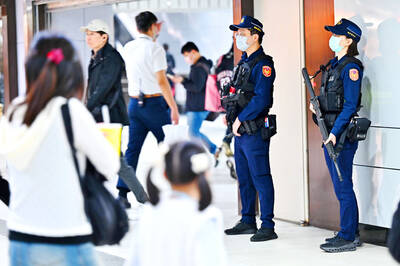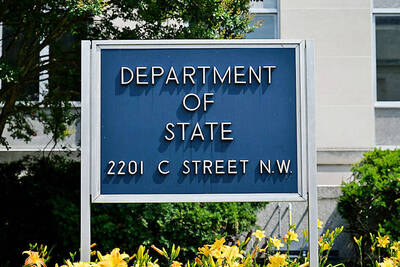Despite efforts by the administration of President Ma Ying-jeou (馬英九) to lower tensions in the Taiwan Strait, the Chinese military continues to build up its missile threat against its neighbor, according to recent reports of modernization efforts at missile bases in China’s Fujian Province.
Reports late last month said recent US spy satellite imagery had uncovered what appeared to be evidence of new missile launch pads in Fujian Province, including in Xianyou in the province’s southeast, directly -opposite Taiwan.
However, according to the latest issue of British defense magazine Jane’s Defence Weekly, the imagery was likely evidence of modernization of an old People’s Liberation Army (PLA) missile brigade under direct control of the Nanjing Military Region rather than new missile bases.
Military analysts suspect that command of the ground support missile brigade at Xianyou, which became operational in 1993, was recently shifted to the Second Artillery Corps, which oversees China’s conventional and nuclear ballistic missile forces.
Prior to falling under control of the Second Artillery’s 52 Base, the missile brigade around Xianyou comprised about 100 Dong Feng 11 (DF-11) short-range (300km) ballistic missiles (SRBM).
As part of ongoing modernization efforts, those missiles are now believed to be in the process of being replaced by the more modern 600km-range DF-11As, Jane’s said.
The DF-11 is a solid-fuel, road-mobile SRBM carried on transporter erector launcher (TEL) vehicles.
In earlier reports, Kanwa Asia Defense Review claimed that along with new equipment, the base may also have been given a new mission, Jane’s reported.
The Second Artillery’s main ballistic missile base in Fujian, 817 Brigade, is located in Yongan City. Six brigades of DF-11As are believed to be based there.
The brigades at Xianyou and Yongan are part of the PLA’s ballistic missile force, estimated at 1,500 missiles, targeted at Taiwan, an arsenal that includes medium-range DF-15s and DF-16s, as well as hundreds of cruise missiles.
Commenting on the imagery, Kanwa Asia Defense Review claimed that two of the new launch pads were constructed in northern Fujian, with one located 100km northwest of Fuzhou, less than 260km from Taipei.
At least two launch pads have also been detected on mountaintops in the Huashuang area, about 270km from Taipei. Yet another launch pad has been spotted 209km from Taipei, which the magazine said was also built prior to 2007 and is now under the control of No. 820 artillery brigade based in Jinhua, Zhejiang Province.
However, Gary Li, an intelligence analyst at UK-based Exclusive Analysis, said that without closer analysis of the imagery, it was impossible to rule out the possibility that some of the so-called launch pads seen around Fujian were fake TELs — which the PLA has reportedly been fielding in increasing numbers to deceive satellites — or long-range multiple rocket launchers such as the PHL-03s used by the army.
Commenting on the reports, local military experts said China had also strengthened its ability to protect its ballistic missiles with air-defense systems.
Ministry of National Defense spokesman David Lo (羅紹和) said the ministry has stepped up its monitoring of China’s military deployments and movements and would work out response strategies to protect national security.
The reports come amid news that three Patriot Advanced Capability-2 (PAC-2) surface-to-air missile defense units acquired by Taiwan in the late 1990s were recently returned to Taiwan after being upgraded to PAC-3 configuration in the US.
Additional reporting by CNA

A car bomb killed a senior Russian general in southern Moscow yesterday morning, the latest high-profile army figure to be blown up in a blast that came just hours after Russian and Ukrainian delegates held separate talks in Miami on a plan to end the war. Kyiv has not commented on the incident, but Russian investigators said they were probing whether the blast was “linked” to “Ukrainian special forces.” The attack was similar to other assassinations of generals and pro-war figures that have either been claimed, or are widely believed to have been orchestrated, by Ukraine. Russian Lieutenant General Fanil Sarvarov, 56, head

SAFETY FIRST: Double the number of police were deployed at the Taipei Marathon, while other cities released plans to bolster public event safety Authorities across Taiwan have stepped up security measures ahead of Christmas and New Year events, following a knife and smoke bomb attack in Taipei on Friday that left four people dead and 11 injured. In a bid to prevent potential copycat incidents, police deployments have been expanded for large gatherings, transport hubs, and other crowded public spaces, according to official statements from police and city authorities. Taipei Mayor Chiang Wan-an (蔣萬安) said the city has “comprehensively raised security readiness” in crowded areas, increased police deployments with armed officers, and intensified patrols during weekends and nighttime hours. For large-scale events, security checkpoints and explosives

PUBLIC SAFETY: The premier said that security would be tightened in transport hubs, while President Lai commended the public for their bravery The government is to deploy more police, including rapid response units, in crowded public areas to ensure a swift response to any threats, President William Lai (賴清德) said yesterday after a knife attack killed three people and injured 11 in Taipei the previous day. Lai made the remarks following a briefing by the National Police Agency on the progress of the investigation, saying that the attack underscored the importance of cooperation in public security between the central and local governments. The attack unfolded in the early evening on Friday around Taipei Main Station’s M7 exit and later near the Taipei MRT’s Zhongshan

REBUFFED: In response to Chinese criticism over recent arms sales, Washington urged Beijing to engage in meaningful dialogue instead of threats and intimidation Washington’s long-term commitment to Taiwan would not change, the US Department of State said yesterday, urging Beijing to stop pressuring Taiwan and engage in meaningful bilateral dialogues. The remarks came in response to a backlash from Beijing about Washington’s latest approval of arms sales to Taiwan. The US Defense Security Cooperation Agency said in a statement on Wednesday that the Taipei Economic and Cultural Representative Office in the US has asked to purchase an arms package, including Tactical Mission Network Software; AH-1W helicopter spare and repair parts; M109A7 self-propelled howitzers; HIMARS long range precision strike systems; tube-launched, optically tracked, wire-guided missiles; Javelin